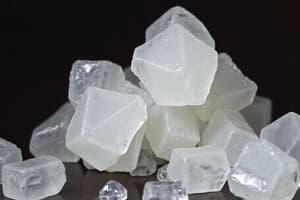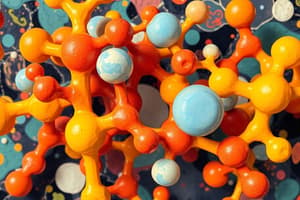Podcast
Questions and Answers
What stoichiometric formula represents carbohydrates?
What stoichiometric formula represents carbohydrates?
(CH2O)n
In carbohydrate molecules, what is the ratio of carbon to hydrogen to oxygen?
In carbohydrate molecules, what is the ratio of carbon to hydrogen to oxygen?
1:2:1
Scientists classify carbohydrates into which of the following subtypes?
Scientists classify carbohydrates into which of the following subtypes?
- Monosaccharides
- Disaccharides
- Polysaccharides
- All of the above (correct)
What suffix do most monosaccharide names end with?
What suffix do most monosaccharide names end with?
What type of group does a sugar have if it is an aldose?
What type of group does a sugar have if it is an aldose?
What is the chemical formula for glucose?
What is the chemical formula for glucose?
What are the common monosaccharides?
What are the common monosaccharides?
Glucose, galactose, and fructose are structural isomers
Glucose, galactose, and fructose are structural isomers
What are the two different hydroxyl group arrangements (OH) around the anomeric carbon for glucose in a ring form?
What are the two different hydroxyl group arrangements (OH) around the anomeric carbon for glucose in a ring form?
What forms when two monosaccharides undergo a dehydration reaction?
What forms when two monosaccharides undergo a dehydration reaction?
What type of bond do scientists call the bond formed when a covalent bond forms between two monosaccharides?
What type of bond do scientists call the bond formed when a covalent bond forms between two monosaccharides?
Name a disaccharide consisting of the monomers glucose and galactose?
Name a disaccharide consisting of the monomers glucose and galactose?
Name a disaccharide formed by a dehydration reaction between two glucose molecules.
Name a disaccharide formed by a dehydration reaction between two glucose molecules.
What monosaccharides comprise sucrose (table sugar)?
What monosaccharides comprise sucrose (table sugar)?
What is a long chain of monosaccharides linked by glycosidic bonds?
What is a long chain of monosaccharides linked by glycosidic bonds?
Name the two polymers that comprise starch in plants?
Name the two polymers that comprise starch in plants?
What does unbranched glucose monomer chains from?
What does unbranched glucose monomer chains from?
What glycosidic bonds comprise amylose?
What glycosidic bonds comprise amylose?
What is the storage form of glucose in humans and other vertebrates?
What is the storage form of glucose in humans and other vertebrates?
What is the most abundant natural biopolymer?
What is the most abundant natural biopolymer?
What type of glycosidic bonds comprise cellulose?
What type of glycosidic bonds comprise cellulose?
Flashcards
Carbohydrate
Carbohydrate
A class of organic compounds with the stoichiometric formula (CH2O)n, where n is the number of carbons.
Monosaccharide
Monosaccharide
Simple sugars, often with 3 to 7 carbon atoms. Names typically end in '-ose'.
Aldose
Aldose
A monosaccharide with an aldehyde group (R-CHO).
Ketose
Ketose
Signup and view all the flashcards
Trioses
Trioses
Signup and view all the flashcards
Pentoses
Pentoses
Signup and view all the flashcards
Hexoses
Hexoses
Signup and view all the flashcards
Glucose
Glucose
Signup and view all the flashcards
Galactose
Galactose
Signup and view all the flashcards
Fructose
Fructose
Signup and view all the flashcards
Isomers
Isomers
Signup and view all the flashcards
Asymmetric Carbon
Asymmetric Carbon
Signup and view all the flashcards
Anomeric Carbon
Anomeric Carbon
Signup and view all the flashcards
Disaccharide
Disaccharide
Signup and view all the flashcards
Dehydration Reaction
Dehydration Reaction
Signup and view all the flashcards
Glycosidic Bond
Glycosidic Bond
Signup and view all the flashcards
Alpha (α) Glycosidic Bond
Alpha (α) Glycosidic Bond
Signup and view all the flashcards
Beta (β) Glycosidic Bond
Beta (β) Glycosidic Bond
Signup and view all the flashcards
Lactose
Lactose
Signup and view all the flashcards
Maltose
Maltose
Signup and view all the flashcards
Sucrose
Sucrose
Signup and view all the flashcards
Polysaccharide
Polysaccharide
Signup and view all the flashcards
Starch
Starch
Signup and view all the flashcards
Amylose
Amylose
Signup and view all the flashcards
Amylopectin
Amylopectin
Signup and view all the flashcards
Glycogen
Glycogen
Signup and view all the flashcards
Glycogenolysis
Glycogenolysis
Signup and view all the flashcards
Cellulose
Cellulose
Signup and view all the flashcards
Chitin
Chitin
Signup and view all the flashcards
Fiber Benefits
Fiber Benefits
Signup and view all the flashcards
Study Notes
- Carbohydrates have a stoichiometric formula of (CH2O)n, where n is the number of carbon atoms
- The ratio of carbon to hydrogen to oxygen is 1:2:1 in carbohydrate molecules
- Scientists classify carbohydrates into monosaccharides, disaccharides, and polysaccharides
Monosaccharides
- Monosaccharides are simple sugars; glucose is most common
- They contain three to seven carbon atoms
- Monosaccharide names end with the suffix -ose
- Sugars with an aldehyde group (R-CHO) are aldoses
- Sugars with a ketone group (RC(=O)R') are ketoses
- Trioses contain three carbons
- Pentoses contain five carbons
- Hexoses contain six carbons
- Glucose has the chemical formula C6H12O6
- Glucose provides a source of energy
- During cellular respiration, energy is released from glucose to make ATP
- Plants use carbon dioxide and water to synthesize glucose, meeting their energy needs
- Humans and animals catabolize starch to get glucose
- Galactose and fructose are other common monosaccharides
- Glucose, galactose, and fructose share the chemical formula (C6H12O6)
- Isomers structurally and chemically differ in the arrangement of functional groups around the asymmetric carbon
- Glucose, galactose, and fructose are isomeric monosaccharides (hexoses)
- Glucose and galactose are aldoses
- Fructose is a ketose
- Monosaccharides exist as linear chains or ring-shaped molecules, but exist in ring forms in aqueous solutions
- In ring form, glucose has two hydroxyl group arrangements (OH) around the anomeric carbon: alpha (α) position, and beta (β) position
Disaccharides
- Disaccharides form when two monosaccharides undergo dehydration reaction (condensation reaction/dehydration synthesis)
- During this process, one monosaccharide's hydroxyl group combines with another monosaccharide's hydrogen
- This then releases a water molecule and forms a covalent bond between carbohydrate molecules
- The covalent bond between carbohydrates is called a glycosidic bond
- Glycosidic bonds (or glycosidic linkages) can be alpha or beta type
- An alpha bond is formed when the OH group on the carbon-1 of the first glucose is below the ring plane
- A beta bond is formed when the OH group on the carbon-1 is above the ring plane
- Common disaccharides include lactose, maltose, and sucrose
- Lactose consists of the monomers glucose and galactose; and is naturally found in milk
- Maltose (or malt sugar) forms from two glucose molecules
- Sucrose (or table sugar) consists of glucose and fructose monomers
Polysaccharides
- A long chain of monosaccharides linked by glycosidic bonds is a polysaccharide
- Polysaccharides can be branched or unbranched and contain different types of monosaccharides
- The molecular weight may be 100,000 daltons or more
- Starch, glycogen, cellulose, and chitin are primary examples of polysaccharides
- Plants store sugars in the form of starch
- Amylose and amylopectin (both glucose polymers) comprise these sugars
- Plants synthesize and store excess glucose as starch in different plant parts, including roots and seeds
- Starch in seeds provides food for the embryo and serves as humans/animals' food source
- Amylase in saliva breaks down starch into smaller molecules (maltose and glucose)
- Monomers in glucose starch are joined by α 1-4 or α 1-6 glycosidic bonds
- The numbers 1-4 and 1-6 refer to the carbon number of the two residues joined to form the bond
- Unbranched glucose monomer chains (α 1-4 linkages) form the starch amylose
- Amylopectin is a branched polysaccharide (α 1-6 linkages at branch points)
- Glycogen is the storage form of glucose in humans/other vertebrates, comprised of monomers of glucose
- Glycogen is the animal equivalent of starch, stored in liver/muscle cells
- When glucose levels drop, glycogen breaks down to release glucose in glycogenolysis
- Cellulose makes up a plant's cell wall, providing structural support
- Wood and paper are mostly cellulosic
- Glucose monomers comprise cellulose linked by β 1-4 glycosidic bonds
- Glucose monomers form hydrogen bonds, holding chains firmly together side-by-side, forming strong microfibrils
- Human digestive enzymes cannot break down the β 1-4 linkage
- Herbivores (cows, koalas, and buffalos) can digest plant material rich in cellulose
- Species of bacteria/protists in the rumen secrete the cellulase enzyme
- Cellulases break down cellulose into glucose monomers for energy
- Termites can also break down cellulose because of organisms in their bodies
- Carbohydrates serve various functions in different animals
- Exoskeletons in Arthropods (insects, crustaceans, etc.) are made of chitin (nitrogen-containing polysaccharide)
- Chitin has repeating N-acetyl-β-d-glucosamine units and is found in fungal cell walls
Benefits of Carbohydrates
- Carbohydrates are an important part of the human diet
- A gram of carbohydrate contains 4.3 Kcal; fat contain 9 Kcal/g
- Fiber, the insoluble part of carbohydrates, promotes bowel movement, regulates blood glucose, and removes excess cholesterol
- Fiber attaches to cholesterol and prevents cholesterol particles from entering the bloodstream
- Fiber-rich diets may reduce in colon cancer
- Meals with whole grains/vegetables gives a feeling of fullness
- Glucose breaks down during cellular respiration to make ATP, providing an immediate source of energy
Studying That Suits You
Use AI to generate personalized quizzes and flashcards to suit your learning preferences.




